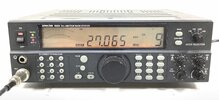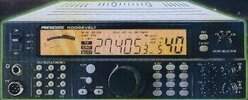So, here's my idea for a killer CB product. It's an upgrade for millions of "black" base-station radios based on the RCI2950 circuit board. This is a long list of models over the last 30-plus years. The tuning knob on these radios is a rotary encoder. In this case it's called a "quadrature" encoder. It closes two sets of contact points in a sequence. Which one closes first tells the computer which direction you turned it. These contacts close only when the knob is in between detent clicks. The radio's computer moves the frequency up or down with each click. Both contact points are an open circuit when the knob is at rest. Just one problem. The contacts are prone to "bounce", or make/break the circuit multiple times when they touch. The contacts must have spring tension to draw them back apart between clicks. But you can't make the springs so tight that they won't exhibit this multiple-make/break bounce behavior. The computer is supposed to compensate for contact bounce, but there's a limit to how effective this can be.
The tuning knob on the mobile radios behaves itself fairly well. You can confuse the computer if you spin it really fast but the one used in base radios is different. The control in the mobile radios has a solid 6mm shaft with a flat spot that engages the knob. The base radio encoders have a 6mm split shaft with splines. It takes a totally different and larger tuning knob than the mobile radios.
You would think they're both the same on the inside, but not so much. The base station tuning knob is famously flaky. Might jump six channels with one click, might move the channel the wrong way from how the knob was turned.
Flaky.
A better choice of rotary encoder type is called a "gray code" encoder. The simplest, and cheapest has only a two-bit binary code that closes a circuit to ground on each pin. The difference is that this type is "static", meaning that the on-off pattern is always there, not just while you're turning the knob. Naturally the computer code that responds to this type encoder is different from what's needed for the quadrature type.
I looked for gray-code encoders for years that had a shaft that matches the knob on these radios. The idea is to interpret the new encoder with a simply tiny computer and output pulses to ground that mimic the factory encoder.
But without the contact bounce that causes the flaky response. A chip that provides a clean version of what should come out of the factory encoder should fix this problem and make that knob useable.
And guess what just turned up on chinabay? A proper gray-code encoder with that split spline shaft.
I wrote code for gray code encoders decades ago for a synthesizer we used to make. Might be adaptable for this.
One thing I don't have is the upper/lower limits for how the radio's computer responds to the factory encoder. How long must I make the pulse coming out of a controller chip to properly mimic the factory encoder? How fast can they repeat without acting flaky like the factory setup? There has to be some minimum interval between "clicks".
Sounds like a research project that calls for an unrealistic pile of "round tuits".
Unless someone else has already had this idea and done some of the preliminary research, to establish specifications of how the old encoder's timing would have to be matched.
Ideally, this thing would go into the hole in the radio's front panel, plug and play.
Just not enough round tuits.
73



